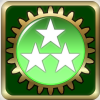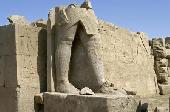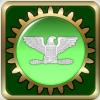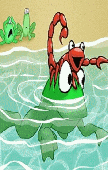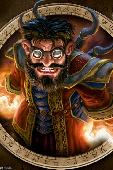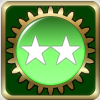-
Sat 3rd Nov 2012 10:08 #1 / 17Seriously it's not.
I haven't been playing here long, but I notice that I'm leaning more and more towards games with med or heavy fog.
No fog games seem to be much more likely to lead to drawn out stalemates and boring slogs (especially if the cards are only 5'ers), and your more likely to get punished for good (or maybe I should say aggressive) play. You got to play good, but not TOO good or the whole map could turn against you. It seems harder to be sneaky or creative. No, "here's a weak little one troop," secretly backed up by 50 in the next territory just waiting to pounce.
I don't know if it's affecting my win percentage any, (would that be something that could be tracked?), but fog seems much more exciting, even when I lose because some one comes out of nowhere to smash me, I will always go back and watch that history.
I know I also take more time thinking through my moves with fog, sometimes even looking at the board, and then coming back later after I've had time to soak in the possibilities, where with no fog I'm usually done in a minute (except for maybe A&A).
Not sure about total fog yet, except maybe in team or non-neutrals games where Fog=Enemy.
Just me? Thoughts? Anyone want to argue for No Fog?
-
Sat 3rd Nov 2012 10:56 #2 / 17https://sites.google.com/site/m57sengine/home
I would agree with your overall assessment. Play in fogged games is less stable by nature, and I think that on many if not on most boards, it enhances game play.
More interesting to me is that many designers now build fog into the mechanics of their boards, and I'll predict you will see fog creatively built-into boards even more as more powerful designer tools expand possibilities.
-
 Sat 3rd Nov 2012 19:28 #3 / 17
Sat 3rd Nov 2012 19:28 #3 / 17
I have about half of a post for the designers forum that I've been sitting on for a few weeks now, talking about this. Basically my argument is that more boards should use medium fog + view borders. IMO, no fog & even light fog (to a lesser extent) are very hard to design game boards for that don't lead to stalemates. this is especially true for boards that are large and/or open. If it's a small map with tight choke points then no/light fog is fine.
The thing is, I don't really like the medium/heavy fog boards either, because they are so foggy that luck can become too important. For example, in a foggy game, the player who happens to go for an area of the board that no one else is attempting to control will have a huge advantage.
So my solution has been to use medium fog with various view borders to give players enough information to have some idea what is going on (who is establishing where and a general idea of how powerful players are) without giving away exactly who is in the lead.
Some examples of what I am talking are my Crystals & Caves board. Depending on the scenario you have various view borders that give you views of the board:
http://www.wargear.net/boards/view/Crystal+Caves
Just Gems - all gems of the same color view each other.
Default - castle can view other castles:
Castles & Towers - Same as default + towers provide view several territories away.
Another example:
My Q-bert board: @!#?@!? It's heavy fog, but the flying disks on the side of the pyramid provide view to almost half the board when you take one.
Also my simple worlds - capitals scenario. Take a capital and you can see the entire continent + a few territories beyond.
Finally I have started using the concept of 'distant-N' fog, which is something I have used on several boards already. Basically 'distant-N' fog is like medium fog, but in medium fog you can just see the territory immediately adjacent to you. In distant-N fog you can see not just the immediatly adjacent territory, but ones N away from you. So 'distant-1 fog' is the same as medium fog. Distant-2 fog allows you to see another territory further, etc. Usually in distant-2 or distant-3 games you start off being able to see the entire board, and then as players positions consolidate, you can see the area you can control + a bit more, but it's usually enough to have a better idea what is going on, and have some idea where each player has established & their strength in the early/mid game.
-
 Sat 3rd Nov 2012 19:30 #4 / 17
Sat 3rd Nov 2012 19:30 #4 / 17
Also why I am advocating for more control over fog options. Things like having view borders that just show possession, but not unit counts, and separate fog control over card counts & reserves.
You can imagine a board which allowed you to hold unlimited cards & reserves with both being fogged . Even if the board itself was not fogged, the leader could 'store' units in cards & reserves so as not to make themselves as much of a target.
-
 Sat 3rd Nov 2012 19:57 #5 / 17
If wars were won by arithmetic
Sat 3rd Nov 2012 19:57 #5 / 17
If wars were won by arithmeticI disagree. I feel that fog works in some maps and not in others. Sometimes the design of the map itself relies on knowing what is going on on the rest of the map. It allows the players to make decisions that may not effect the game for that turn but is a strategy for later in the game.
My main example of this is Rent is Due. That map is based off of the choke points and I feel with fog the map takes a more "Attack and Pray" style of play, while with no fog you know what is going on in the other half of the map and may decide against trying to take the Master Bedroom because a player has the kitchen and dining room and could make a strong play through the living room and you would lessen the strength of your choke point.
That being said, there are games where fog is used very very well. Salem's Dusk is the best example because the fog adds to the errie feeling of the map. I also love it in Total Wargear II because it doesn't let you know what exactly is going on but still gives you a good idea of the strength of the other players so it doesn't take from the strategy of playing the map.
Of course I'm an offensive player (and person) and so I set up my maps for the attack and fog lends itself to more of a controlled defensive style of play. I do love the "View Only Borders" like used in Castles because it kind of has both styles there.If you are only going to play fog maps I think you are limiting yourself to a certain style of play. There are some maps I just won't play because I don't like the use of fog on them. I do agree that Fog should be an option for players to add or subtract unless it is crucial to the gameplay like in Gauntlet or Salem's Dusk.
I'm RiskyBack and I approve this posting
We'd be ruled by the mathematicians
-
 Sat 3rd Nov 2012 20:00 #6 / 17
Sat 3rd Nov 2012 20:00 #6 / 17
It seems that a lot of the incentive for having fog on boards is to prevent stalemates. There has to be a way to break stalemates with board design that do not involve fog, maybe we can focus on that in addition to talking about fog.
-
 Sat 3rd Nov 2012 20:27 #7 / 17
Sat 3rd Nov 2012 20:27 #7 / 17
SquintGnome wrote:
It seems that a lot of the incentive for having fog on boards is to prevent stalemates. There has to be a way to break stalemates with board design that do not involve fog, maybe we can focus on that in addition to talking about fog.
I think that's a tough nut to crack, and it has been discussed here before. The discussion I remember was one I started when I first came to this site:
http://www.wargear.net/forum/showthread/1259p1/The_dreaded_crab_game
One suggestion I had there, was a sort of time-bomb that could be set by the designer. The basic idea is that after some period of stalemate the game engine does something to shake things up. There are lots of ways this could be implemented:
Trigger conditions:
Lead doesn't change in N turns.No continents are gained/lost in N turns.
Unit counts for all players go up for N consecutive turns.
Results:
Player with most units wins.
Player with least units eliminated.
Some % of territories are shuffled.
Some % of units for all players are killed.
Lots of these combinations would work and I think would be fun to play. Some might seem unfair, but if you know about them ahead of time, then it is just another condition to consider. If you really did not want the triggered action to occur, then you would have to work to make sure the trigger does not activate.
-
 Sat 3rd Nov 2012 21:27 #8 / 17
"If an incompetent chieftain is removed, seldom do we appoint his highest-ranking subordinate to his place" - Attila the Hun
Sat 3rd Nov 2012 21:27 #8 / 17
"If an incompetent chieftain is removed, seldom do we appoint his highest-ranking subordinate to his place" - Attila the HunOzyman wrote:
SquintGnome wrote:
It seems that a lot of the incentive for having fog on boards is to prevent stalemates. There has to be a way to break stalemates with board design that do not involve fog, maybe we can focus on that in addition to talking about fog.
I think that's a tough nut to crack, and it has been discussed here before. The discussion I remember was one I started when I first came to this site:
http://www.wargear.net/forum/showthread/1259p1/The_dreaded_crab_game
One suggestion I had there, was a sort of time-bomb that could be set by the designer. The basic idea is that after some period of stalemate the game engine does something to shake things up. There are lots of ways this could be implemented:
Trigger conditions:
Lead doesn't change in N turns.No continents are gained/lost in N turns.
Unit counts for all players go up for N consecutive turns.
Results:
Player with most units wins.
Player with least units eliminated.
Some % of territories are shuffled.
Some % of units for all players are killed.
Lots of these combinations would work and I think would be fun to play. Some might seem unfair, but if you know about them ahead of time, then it is just another condition to consider. If you really did not want the triggered action to occur, then you would have to work to make sure the trigger does not activate.
I like the idea of victory conditions.
The stalemates I've been in are usually more of a dynamic equilibrium than a static one. Normally with 3 remaining players there is a leader in either bonus or units or both, and the two underdogs work together to bring the leader down. Then this causes a slight imbalance as the new leader is established, and the cycle continues.
-
 Sat 3rd Nov 2012 23:10 #9 / 17
Sat 3rd Nov 2012 23:10 #9 / 17
Lots of good ideas there Ozy, I like best the idea of dropping the lowest player after N turns of a certain condition
-
 Sat 3rd Nov 2012 23:18 #10 / 17
Sat 3rd Nov 2012 23:18 #10 / 17
>The stalemates I've been in are usually more of a dynamic equilibrium than a static one. Normally with 3 remaining players there is a leader in either bonus or units or both, and the two underdogs work together to bring the leader down. Then this causes a slight imbalance as the new leader is established, and the cycle continues.
That's a good point. Any thoughts on how to test for a dynamic equilibrium? Maybe some way you could look at total unit counts? I guess it would also depend on other game attributes. An increasing card scale with card capture would eventually resolve if unit counts were staying flat, but for other games constant-ish unit counts might mean a deadlock.
-
 Sun 4th Nov 2012 00:55 #11 / 17
"I shall pass this but once, any good I can do, or kindness I can show; let me do it now. Let me not difer nor neglect it, for I shall not pass this way again." -Stephen Grellet
Sun 4th Nov 2012 00:55 #11 / 17
"I shall pass this but once, any good I can do, or kindness I can show; let me do it now. Let me not difer nor neglect it, for I shall not pass this way again." -Stephen GrelletThis is actually the reason that I came up with that oil producing nation mechanic, to turn the game into one with phases after the players have accomplished a certain set of things. Which will address the crab game problem all throughout the map. Just haven't had the time to develop it.
But think about it, if there is a certain amount of oil on the map, and the players use it all up, the game moves on to another phase - which could play very differently. It's a map build in of the time bomb.
-
 Sun 4th Nov 2012 05:45 #12 / 17
https://sites.google.com/site/m57sengine/home
Sun 4th Nov 2012 05:45 #12 / 17
https://sites.google.com/site/m57sengine/homeThese are good ideas. In this thread (post #53), I proposed a number of similar "Victory Conditions" and a way to implement them.
Here's a thread where another method to implement VC (widgets) was discussed.
-
 Sun 4th Nov 2012 11:53 #13 / 17
Sun 4th Nov 2012 11:53 #13 / 17
Ozyman wrote:
>The stalemates I've been in are usually more of a dynamic equilibrium than a static one. Normally with 3 remaining players there is a leader in either bonus or units or both, and the two underdogs work together to bring the leader down. Then this causes a slight imbalance as the new leader is established, and the cycle continues.
That's a good point. Any thoughts on how to test for a dynamic equilibrium? Maybe some way you could look at total unit counts? I guess it would also depend on other game attributes. An increasing card scale with card capture would eventually resolve if unit counts were staying flat, but for other games constant-ish unit counts might mean a deadlock.
An easy but simple method to test for dynamic equlibrium is:No players eliminated in 10 turns
You would start the clock ticking after any player is eliminated. Once the criteria is met the player with the least units is eliminated.
This, of course, would also work for static equilibrium. You could tweak the number of turns criteria based on the current number of players, etc.
-
 Sun 4th Nov 2012 12:24 #14 / 17
https://sites.google.com/site/m57sengine/home
Sun 4th Nov 2012 12:24 #14 / 17
https://sites.google.com/site/m57sengine/homeSquintGnome wrote:
An easy but simple method to test for dynamic equlibrium is:No players eliminated in 10 turns
You would start the clock ticking after any player is eliminated. Once the criteria is met the player with the least units is eliminated.
This, of course, would also work for static equilibrium. You could tweak the number of turns criteria based on the current number of players, etc.
There's a lot of subjectivity here ..but then, it's a designer feature so..
I guess I have an old-school bias on this one. Namely, a board that is prone to stalemate is just not a well designed board, and that when a position does become stalemate-ish, good players find ways to deal with it.
On the other hand, I suppose someone might envision an application where a board is actually designed to stay close to equilibrium, and the influence of the rule becomes an integral part of how the game is played from the start. If someone could give me an example of such a board, I could get excited about this particular Victory Condition feature.
-
 Sun 4th Nov 2012 12:36 #15 / 17
"I shall pass this but once, any good I can do, or kindness I can show; let me do it now. Let me not difer nor neglect it, for I shall not pass this way again." -Stephen Grellet
Sun 4th Nov 2012 12:36 #15 / 17
"I shall pass this but once, any good I can do, or kindness I can show; let me do it now. Let me not difer nor neglect it, for I shall not pass this way again." -Stephen GrelletI just picture myself: counting the 8th turn, thinking... if I'm not stronger than that guy in 2 turns... willing someone else to make a mistake.... sweating bullets... and then BAM. Eliminated. :(
The ability to set this would change the game drastically. And it would ensure that a prolonged setup cannot happen either. Your really encouraging players to make bold moves before their dead anyway.
-
 Sun 4th Nov 2012 12:38 #16 / 17
Sun 4th Nov 2012 12:38 #16 / 17
Your question is a good one M, but I can take another perspective. Regardless of the board design, if you go 10-15 rounds without something happening there needs to be a 'reboot' button. This could be a first step 'reboot'; and while that is in place designers can then work towards not having their games lock up. Just like computers, you reboot when the computer freezes and the programmers work to not having the computer freeze. But you need the ability to reboot to avoid tearing you hair out.
-
 Sun 4th Nov 2012 13:14 #17 / 17
"If an incompetent chieftain is removed, seldom do we appoint his highest-ranking subordinate to his place" - Attila the Hun
Sun 4th Nov 2012 13:14 #17 / 17
"If an incompetent chieftain is removed, seldom do we appoint his highest-ranking subordinate to his place" - Attila the HunSquintGnome wrote:
Ozyman wrote:
>The stalemates I've been in are usually more of a dynamic equilibrium than a static one. Normally with 3 remaining players there is a leader in either bonus or units or both, and the two underdogs work together to bring the leader down. Then this causes a slight imbalance as the new leader is established, and the cycle continues.
That's a good point. Any thoughts on how to test for a dynamic equilibrium? Maybe some way you could look at total unit counts? I guess it would also depend on other game attributes. An increasing card scale with card capture would eventually resolve if unit counts were staying flat, but for other games constant-ish unit counts might mean a deadlock.
An easy but simple method to test for dynamic equlibrium is:No players eliminated in 10 turns
You would start the clock ticking after any player is eliminated. Once the criteria is met the player with the least units is eliminated.
This, of course, would also work for static equilibrium. You could tweak the number of turns criteria based on the current number of players, etc.
I think that's an excellent way to test for static and dynamic equilibrium. In the end, isn't eliminations what is going to move the game forward? Having this be a board design option makes sense.
The action once this limit is reached is a tricky one. I hear ya, ratsy, if I was in the weaker position. Might even consider suiciding against another player if I knew my time was drawing near...and that's not a good resolution either.
